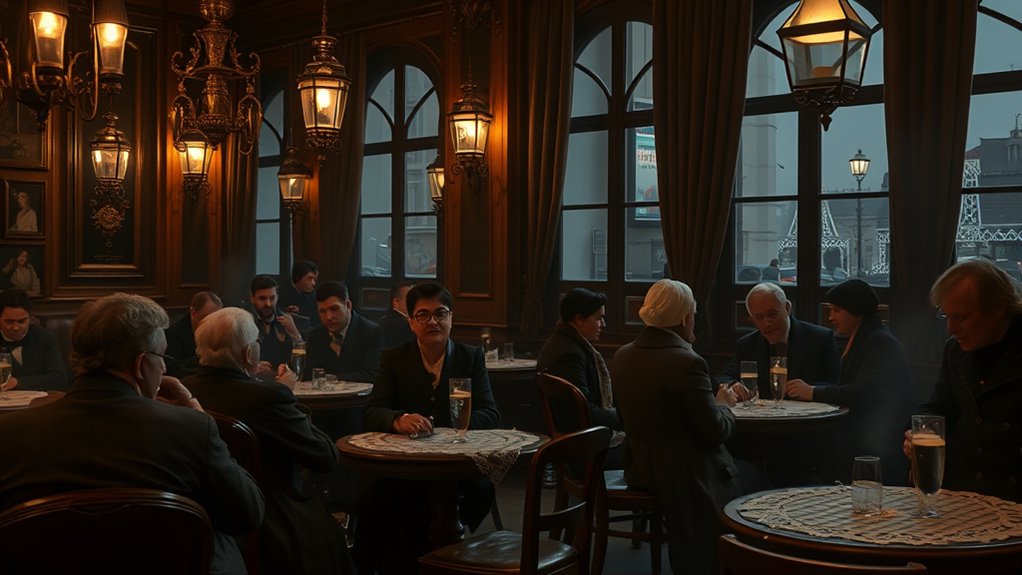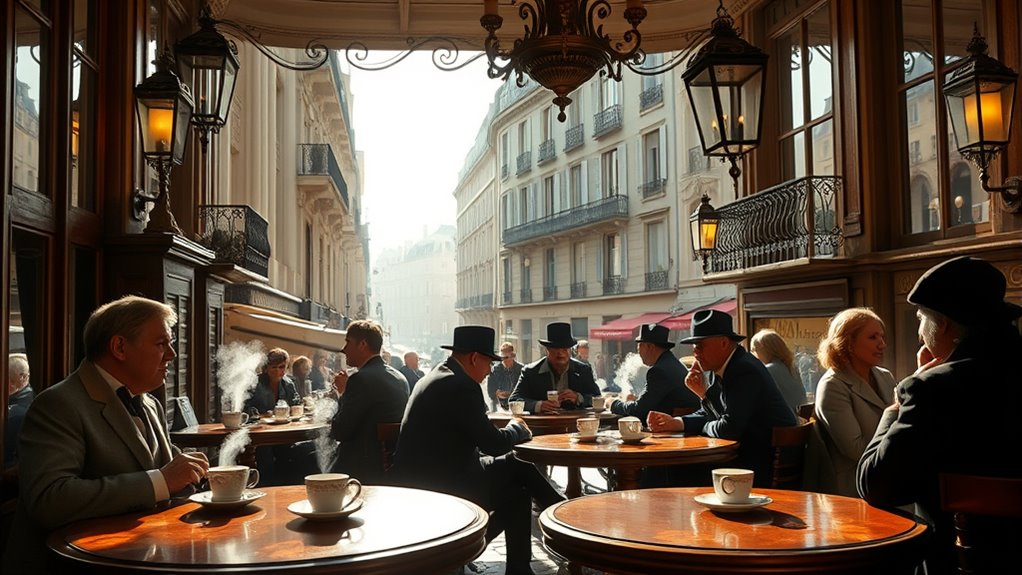In 19th-century Parisian novels, cafés serve as lively social hubs where you see characters gather to debate, flirt, or find inspiration. These spaces reflect the city’s cultural and historical vibe through their ambiance and decor. They act as romantic settings, intensifying emotional moments and sparking connections. As central stages for stories of love, politics, and creativity, cafés embody the spirit of Paris—continue exploring to uncover more about their unique role and charm.
Key Takeaways
- Cafés serve as vital social settings where characters meet, debate, and build relationships, reflecting 19th-century Parisian society.
- They provide atmospheric backdrops that enhance themes of romance, intrigue, and cultural exchange in novels.
- Cafés symbolize the vibrant, lively spirit of Paris, often representing ideas, political movements, or artistic inspiration.
- Their architecture and ambiance mirror the historical and cultural context, enriching narrative immersion.
- Cafés function as stages for personal stories and social interactions, embodying the city’s ongoing conversation and creative energy.

In 19th-century Parisian novels, cafés serve as more than just bustling gathering spots; they embody the vibrant social fabric of the city. When you step into these cafés, you’re entering spaces where characters converge, ideas collide, and stories unfold. The café as a social hub isn’t just about sipping coffee—it’s about connection. Writers often portray these venues as the heartbeat of Parisian life, where friends meet to debate politics, artists sketch drafts, and writers exchange ideas that fuel their creativity. The lively chatter, clinking cups, and rapid-fire exchanges reveal a city thriving on interaction, making the café a microcosm of Parisian society. You can imagine yourself seated amidst the hum of conversation, feeling the pulse of a city that never stops talking. These cafés become stages for social rituals, where social classes mingle and cultural movements spark. They’re places to observe, to participate, and to be part of the city’s ongoing narrative. Additionally, the ambiance and decor of these cafés often reflect the cultural and historical context of 19th-century Paris, enhancing their significance in novels and real life alike.
But the café’s role extends beyond its function as a social hub; it transforms into a romantic setting that fuels countless stories of love and longing. In the pages of these novels, you find characters meeting in cozy corners, whispering secrets over steaming cups, or exchanging glances across the room. The intimate atmosphere of a Parisian café lends itself to romance, offering a private world within the bustling city. It’s easy to picture lovers sitting side by side, lost in conversation, their connection heightened by the warm glow of gas lamps and the aroma of fresh pastries. The café becomes a backdrop for stolen moments, flirtations, and heartfelt confessions. Writers use the setting’s charm to heighten emotional tension, making the café a symbol of passion and intimacy. Whether it’s a chance encounter or a destined reunion, the romantic ambiance of the café elevates everyday interactions into meaningful encounters. You can almost feel the electricity of a first kiss shared in the quiet corner of a Parisian café or the bittersweet farewell over a last cup of coffee.
In these novels, the café is both a stage and a sanctuary—where social life blossoms and love stories unfold. It’s where Parisian characters find inspiration, solace, and excitement within the same warm, lively space. As you read, you realize that for 19th-century Parisians, the café wasn’t just a place to drink; it was an essential part of life’s most significant moments. It captures the essence of a city alive with conversation, creativity, and romance—an enduring symbol of Parisian culture that continues to enchant readers today.
Frequently Asked Questions
Café culture deeply influenced 19th-century Parisian social hierarchies by blurring class boundaries and encouraging class mobility. You could mingle with different social strata, from artists to aristocrats, fostering interactions that challenged strict social stratification. Cafés became spaces where social barriers diminished, allowing you to network, exchange ideas, and even elevate your status. This dynamic environment reshaped traditional hierarchies, making Paris a hub for social and cultural fluidity.
Were Women Equally Represented in Parisian Cafés During This Period?
You might find it charming how women’s presence in Parisian cafés reflected evolving gender dynamics, though true social inclusion was limited. While some women attended more public spaces, many faced restrictions, often lingering in quieter corners or exclusive spots. Their participation increased gradually, signaling subtle shifts in societal attitudes. So, although women weren’t equally represented, their growing visibility marked an important step toward broader social acceptance.
What Role Did Cafés Play in Political Activism and Revolutionary Movements?
Cafés served as essential spaces for political gatherings and revolutionary planning in 19th-century Paris. You could attend secret meetings, exchange ideas, and organize protests, making these venues hubs of activism. They fostered dialogue among revolutionaries and helped spread revolutionary sentiments. By providing a relatively safe environment, cafés empowered citizens to challenge authority and coordinate efforts, critical for shaping the political landscape of the era.
How Authentic Are the Depictions of Cafés in 19th-Century Novels?
You might wonder if these café depictions are genuine or just literary embellishments, and the truth is, they blend both. While authors capture the lively atmosphere and social interactions, they often romanticize or dramatize details for effect. So, authenticity questions arise—some scenes mirror reality, others serve storytelling. Ultimately, these portrayals offer a romanticized glimpse into Parisian café culture, balancing fact with fiction to enchant and engage readers.
Did Cafés Serve as Meeting Places for Artists and Writers Specifically?
Yes, cafés served as meeting places for artists and writers, fostering artistic collaborations and literary gatherings. You’d often find creative minds congregating in these lively spots to exchange ideas, critique work, and inspire each other. These venues became vibrant hubs where new artistic movements emerged, making cafés essential spaces for Parisian cultural life. Your presence at such gatherings would immerse you in the dynamic intellectual atmosphere of 19th-century Paris.
Conclusion
As you close the book, you realize that those Parisian cafes weren’t just settings—they were mirrors of lives intertwined by chance. Who would have thought that a chance encounter over coffee could change a character’s fate? Perhaps, in some way, those stories remind you that life’s most surprising moments often happen where you least expect them—just like in the bustling cafés of 19th-century Paris. Sometimes, coincidence is the real storyteller.









